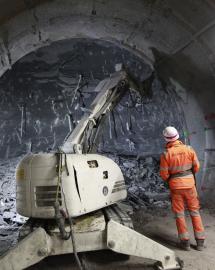Construction phase 4: start of work to excavate large-diameter drift
A new working face is being opened up at the bottom of the R&D drift to complete the first full-scale prototype of a disposal cell for intermediate-level long-lived waste (ILW-LL). The aim of this new test is to demonstrate the feasibility of constructing an excavated drift almost 10 meters in diameter (with a cross-section measuring 85 m²), equipped with a secondary concrete structure as envisaged in the construction licence application.
Construction of the 80-meter prototype will take place over four years in order to test several types of compressible lining and their mechanical strength. After that, a secondary concrete structure will be installed to simulate an equipped ILW-LL disposal cell. As for the other excavation tests, this new drift and the Callovo-Oxfordian rock that surrounds it will be fitted with sensors so that changes in stresses and deformations can be closely monitored.

Construction phase 4: four stages in 2020
This ILW-LL disposal cell forms part of the key experiments for construction phase 4 in support of the construction licence application, and will contribute to preparations for the Cigeo industrial pilot phase if the project is approved. Around 640 meters of additional drifts will be excavated using a hydraulic rock-breaker to meet four objectives set out by the Research and Development, and Engineering Divisions, as discussed with the French Nuclear Safety Authority (ASN) and the French Institute for Radiological Protection and Nuclear Safety (IRSN).
Here is a brief overview of the other major tests in construction phase 4.
- Excavation of an X junction
The basic architecture of Cigeo will have numerous X junctions, chiefly in logistical support areas. The Underground Research Laboratory currently only has T junctions. Intersections are areas in which mechanical stresses are potentially concentrated due to the combination of mechanical stresses in the rock around the two structures.
Where the GER and GT1 drifts meet, the aim will be to demonstrate the feasibility of construction and the good mechanical strength of this type of junction. As for Cigeo, compressible materials will be used for the linings. Sensors will be installed in boreholes oriented towards the future junction in order to monitor the hydromechanical disturbances generated in the rock during drilling and how they change over time.
- Three new HLW disposal cell demonstrators
From the first phase of Cigeo, plans have been in place to construct a pilot section for high-level waste (HLW), where the intention is to replace the air in the disposal cells with an inert gas. At the Underground Research Laboratory, an initial demonstrator 80 meters long will be used to test the gas sampling and inerting system designed to control the internal atmosphere of the disposal cell. The next two demonstrators, which will be shorter (10 meters), will be used to assess the gas exchanges between the drift and the disposal cell, in particular the gas transfer pathways and the limitation of exchanges at the head of the disposal cell.
- Drift backfilling and sealing tests (preceded by surface tests)
To ensure the long-term safety of Cigeo, the plan is to backfill the drifts (excluding the disposal cells) at the end of operation. Without making any prior assumptions about the choices that will be made, tests will be performed in the laboratory (GRE, GET2) to assess, at a scale representative of Cigeo, the construction and hydromechanical behaviour of various backfill solutions. In addition, using the same approach, drift sealing tests will also be performed, notably in preparation for the demonstrators planned for the Cigeo industrial pilot phase.
As usual, all these tests will involve the teams from the Research and Development Division, the Engineering Division, and the Underground Research Laboratory, as well as the service providers who work alongside us.

